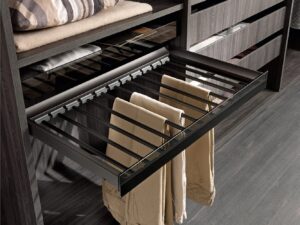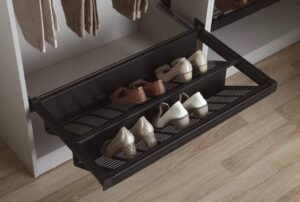Introduction
Are you tired of searching through a cluttered closet every morning, unable to find what you need? A custom wardrobe could be the solution to your wardrobe challenges. Tailoring your closet to suit your lifestyle, storage needs, and personal style can transform how you get ready each day. Designing a closet that works for you isn’t just about aesthetic, it’s about creating a space that maximizes efficiency and organization. In this guide, we’ll walk you through everything you need to know to design a custom wardrobe that meets your needs and complements your lifestyle.
Assess Your Storage Needs
Take Inventory of Your Wardrobe:
The first step in designing a custom wardrobe is to assess what you own. Take inventory of your clothes, shoes, and accessories to get an accurate idea of the space you need. Do you own more hanging items like dresses and coats, or do you need more shelving for folded clothes and shoes? By understanding what you need to store, you can make informed design decisions.
Consider Seasonal Changes:
Do you switch out your wardrobe seasonally? If so, consider adding designated storage areas for off-season items. This will help keep your current wardrobe organized and reduce clutter, ensuring that your closet remains functional all year round.
Design with Functionality in Mind
Optimize Hanging Space:

Depending on your wardrobe, you may need more hanging space for items like blazers, dresses, or suits. Custom wardrobes can include single or double hanging rods to make the most of vertical space. For shorter items like shirts and skirts, opt for double rods to maximize efficiency.
Incorporate Shelving and Drawers:
Shelves and drawers are perfect for items that don’t need to be hung, like sweaters, jeans, and accessories. Adjustable shelves can adapt to different needs over time, offering flexibility as your wardrobe changes. Drawers with dividers can be useful for smaller items like socks, underwear, or jewelry.
Add Shoe Storage:

A dedicated space for shoes is essential to keep your footwear organized and accessible. Depending on your shoe collection, consider pull-out shoe racks, cubbies, or even clear shoe boxes that allow you to see each pair at a glance.
Maximize Small Spaces
Use Vertical Space Efficiently:
In smaller closets, every inch counts. One of the most effective ways to maximize space is by utilizing vertical storage. Install higher shelves for items you don’t use frequently, such as seasonal clothes, and use the space below for daily essentials. Adding hooks to the back of the closet door or inside walls can also provide additional storage for accessories like bags, scarves, and hats.
Sliding Doors for Tight Spaces:
If you’re working with a narrow room or limited floor space, consider installing sliding doors instead of traditional hinged doors. Sliding doors save space and can give your closet a sleek, modern look.
Personalize with Custom Features
Add a Full-Length Mirror:
A full-length mirror is both a practical and stylish addition to any custom wardrobe. It allows you to check your outfit before heading out and reflects light, making the space feel larger. You can even opt for a mirrored door if space is tight.
Install Built-In Lighting:
Good lighting is key to a functional closet. Without proper lighting, it’s difficult to find what you need. Consider adding LED lights under shelves or around the mirror for better visibility. Motion-activated lights are also a great option for walk-in closets, illuminating the space when you step inside.
Drawer Organizers for Accessories:
Custom drawer organizers can help you keep small items like jewelry, ties, belts, and scarves neatly arranged. By having designated compartments, you’ll always know where everything is, and your closet will look tidy and organized.
Choose Quality Materials
Invest in Durable Materials:
When designing a custom wardrobe, the materials you choose are important for both functionality and aesthetics. High-quality materials like wood, metal, and glass are durable and offer a polished, luxurious look. Consider solid wood or MDF (medium-density fiberboard) for shelves, and metal for hanging rods to ensure longevity.
Incorporate Stylish Finishes:
The finishes you select can dramatically impact the look of your wardrobe. Whether you prefer a classic wood finish, modern glass, or sleek matte black handles, the finishing details add personality and style. Choose colors and materials that match your home’s overall aesthetic for a seamless look.
Keep Your Wardrobe Organized
Regular Decluttering:
To maintain your custom wardrobe’s organization, it’s important to regularly declutter. Remove items you no longer wear, and organize what’s left by category. A well-organized closet not only saves you time but also makes your wardrobe feel more luxurious and tailored to your needs.
Use Labels and Dividers:
For those who love organization, labels and dividers can make a big difference. Labeling your storage boxes or using drawer dividers ensures that everything has its place, and it’s easier to maintain order over time.
Leave Room for Future Purchases:
When designing your custom wardrobe, it’s essential to leave space for future purchases. Whether you plan on expanding your shoe collection or adding more clothes, allowing room for growth will help your closet stay functional and organized as your needs change.
Create Versatile Storage Solutions:
By creating versatile storage solutions, you can adapt your wardrobe as your lifestyle changes. Adjustable shelving, removable dividers, and multipurpose drawers will ensure that your closet can accommodate new items over time.
Conclusion
Designing a custom wardrobe that works for you is all about functionality, organization, and personalization. By assessing your storage needs, making smart use of space, and choosing quality materials, you can create a closet that not only looks great but also makes getting dressed a breeze. Whether you choose to DIY or hire a professional, the end result will be a wardrobe tailored perfectly to your lifestyle.
